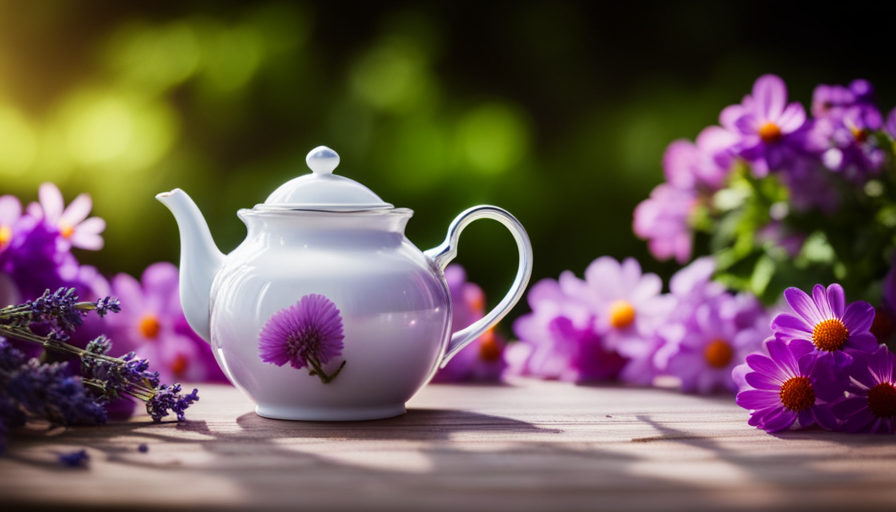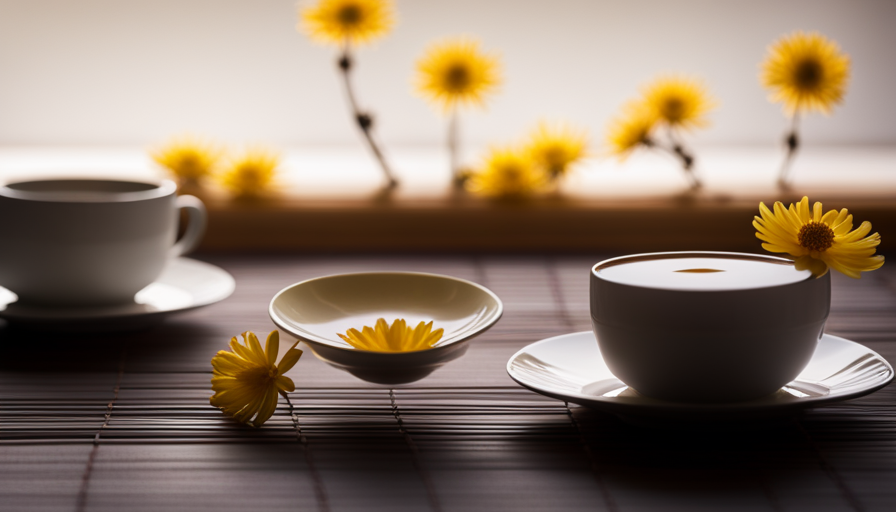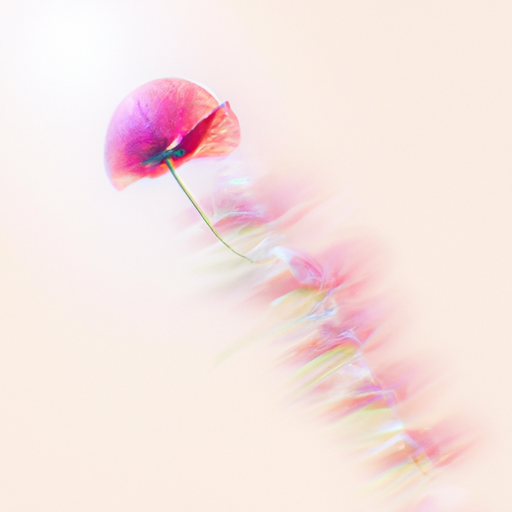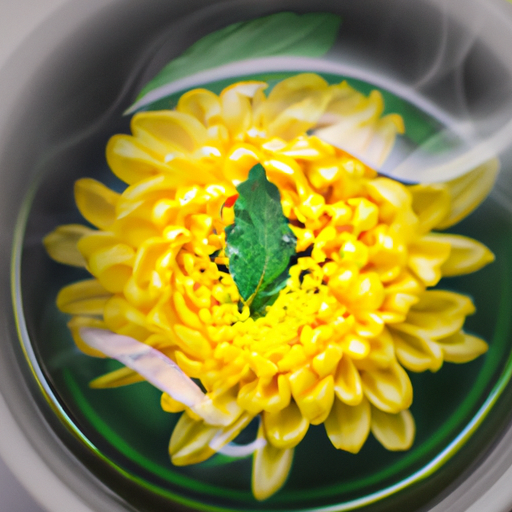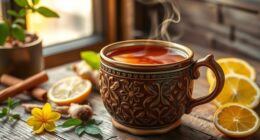Did you know that flowers can be brewed into tasty and calming tea? Yes, it’s true! A recent study found that more than 30% of tea consumers worldwide savor floral blends for their distinct flavors and possible health perks.
As a horticulturalist, I have extensively researched various flowers that are not only suitable for making tea but also possess remarkable botanical characteristics and properties. In this article, I will provide you with scientific and precise information about some of the best flowers for brewing tea. We will explore their scientific names, botanical features, and specific compounds that contribute to their flavor and potential medicinal properties.
I will present this information objectively and without bias, focusing on the botanical facts rather than personal opinions. So, whether you’re a tea connoisseur or simply curious about exploring new tea flavors, join me as we delve into the world of flowers that make exceptional tea.
Key Takeaways
- Roses are suitable for making tea and have numerous benefits, including being rich in antioxidants and flavonoids, boosting the immune system, promoting cardiovascular health, and relieving stress and anxiety.
- Chamomile tea is perfect for promoting relaxation and improving sleep quality, with chamazulene contributing to its flavor and aroma.
- Lavender tea promotes relaxation, reduces anxiety, and enhances sleep quality, although excessive consumption may cause drowsiness or interact with certain medications.
- Hibiscus tea is tangy, refreshing, and high in antioxidants, supporting heart health by lowering blood pressure and cholesterol levels.
Rose
The rose is a beautiful flower that infuses tea with a delicate and romantic aroma. Rose tea, made from the petals of various rose species, has been enjoyed for centuries due to its numerous benefits.
Rose tea is rich in antioxidants, such as vitamin C, which helps boost the immune system and protect against free radicals. It also contains flavonoids that have anti-inflammatory properties, aiding in digestion and promoting cardiovascular health.
To make rose tea, simply steep dried rose petals in hot water for a few minutes. You can also add other ingredients like honey or lemon for added flavor. Rose tea can be served hot or chilled, making it a versatile option for any occasion.
Apart from its health benefits, rose tea is also known for its soothing properties. It can help relieve stress, anxiety, and promote relaxation. Many people enjoy a cup of rose tea before bed to aid in sleep.
However, it’s important to note that some individuals may be allergic to roses, so it’s always advisable to test for any allergic reactions before consuming rose tea regularly.
Moving on to chamomile tea, it’s another popular choice known for its calming effects.
Chamomile
Chamomile is absolutely perfect for brewing a soothing and heavenly cup of herbal infusion. This delightful flower, scientifically known as Matricaria chamomilla, is a member of the Asteraceae family. Chamomile is characterized by its daisy-like appearance, with white petals and a yellow center. The plant itself is herbaceous and grows up to 30 centimeters in height.
When it comes to making tea, chamomile offers numerous benefits. The flowers contain various chemical compounds, including chamazulene, which contributes to its distinct flavor and aroma. Chamomile tea has been used for centuries to promote relaxation, reduce anxiety, and improve sleep quality. It’s also known for its anti-inflammatory properties and can help with digestive issues such as bloating and indigestion.
To paint a picture of chamomile tea, imagine sitting in a cozy chair, holding a warm cup between your hands. The subtle floral scent fills the air as you take a sip, experiencing the gentle sweetness and soothing taste.
Here are five delightful chamomile tea recipes to explore:
- Chamomile and lavender blend for a calming and fragrant infusion
- Chamomile and honey for a touch of natural sweetness
- Chamomile and lemon for a refreshing twist
- Chamomile and mint for a cooling and invigorating drink
- Chamomile and ginger for a warming and spicy brew
As we delve into the next section about lavender, we’ll explore another flower that complements chamomile beautifully.
Lavender
Lavender, scientifically known as Lavandula angustifolia, is a soothing and floral tea that promotes relaxation and reduces anxiety. The delicate purple petals and aromatic fragrance make lavender a popular choice for tea enthusiasts.
Lavender tea is also known for enhancing sleep quality, as it contains compounds such as linalool and linalyl acetate, which have calming effects on the nervous system.
While lavender tea offers many benefits, it’s important to note that excessive consumption may cause drowsiness or interact with certain medications.
Soothing and Floral Tea
Indulge in a cup of tea infused with the delicate and calming essence of rose petals. Roses, scientifically known as Rosa, are a popular choice for creating soothing herbal teas and floral tea blends. The petals of roses are the main ingredient used in tea-making, as they contain essential oils that contribute to their flavor and medicinal properties.
These oils are rich in compounds such as geraniol and citronellol, which give the tea a pleasant floral aroma and a relaxing effect on the body and mind. The petals are carefully harvested and dried, preserving their delicate fragrance and taste.
When steeped in hot water, the petals release their natural oils, creating a fragrant and soothing tea that promotes relaxation and reduces anxiety.
Transitioning into the subsequent section about promoting relaxation and reducing anxiety, other flowers such as chamomile and lavender also have similar properties.
Promoting Relaxation and Reducing Anxiety
Take a moment to discover the potential benefits of sipping on a cup of soothing herbal infusion that’s known to promote relaxation and alleviate anxiety.
As a horticulturalist, I can provide comprehensive information about various flowers suitable for making tea. One such flower is chamomile (Matricaria chamomilla), known for its calming properties. Its daisy-like flowers contain essential oils such as bisabolol, which contributes to its soothing effects.
Another option is lavender (Lavandula angustifolia), which has a floral and slightly sweet flavor. Lavender contains compounds like linalool, known for its relaxation-inducing properties.
Lastly, passionflower (Passiflora incarnata) has been used for centuries as a natural remedy for anxiety. Its unique botanical characteristics, including its intricate purple flowers, make it an intriguing choice for tea. Passionflower contains flavonoids, which have been shown to promote relaxation.
Incorporating these flowers into your tea routine can be a natural and effective way to promote relaxation and reduce anxiety.
Now, let’s delve into how certain flowers can enhance sleep quality.
Enhancing Sleep Quality
To continue our exploration of flowers that are good for tea, let’s delve into the topic of enhancing sleep quality. Many people struggle with insomnia or have difficulty getting a restful night’s sleep, and certain flowers can help improve sleep patterns.
One such flower is chamomile (Matricaria chamomilla), which has been used for centuries as a calming and sedative herb. The daisy-like flowers of chamomile contain compounds that promote relaxation and reduce anxiety, making it an excellent choice for bedtime tea.
Another flower that aids in sleep is lavender (Lavandula angustifolia), known for its soothing aroma and ability to reduce stress.
Additionally, passionflower (Passiflora incarnata) has been used as a natural remedy for insomnia. It contains compounds that induce sleep and improve sleep quality.
Incorporating these flowers into your tea routine can help create a calming bedtime ritual and improve your overall sleep experience.
Now, let’s take a closer look at jasmine and its unique qualities for tea-making.
Jasmine
Enhance your tea experience with the delightful aroma and subtle flavor of jasmine, a flower known for its aromatic properties. Jasmine tea, made from the petals of the Jasminum plant, has been enjoyed for centuries for its numerous benefits. The scientific name for jasmine is Jasminum officinale, and it belongs to the Oleaceae family.
This beautiful flower is native to tropical and subtropical regions, and its blossoms are characterized by their small white petals and sweet fragrance.
Jasmine tea offers various benefits to those who consume it. It’s known for its soothing and calming properties, making it the perfect choice for enhancing sleep quality. The aroma of jasmine has been found to reduce anxiety and promote relaxation, helping individuals achieve a more restful sleep. Additionally, jasmine tea is rich in antioxidants, which can help boost the immune system and protect the body against free radicals.
To make jasmine tea, you can use either dried or fresh jasmine flowers. There are numerous recipes available, ranging from simple jasmine tea infusions to more complex blends with other herbs and spices. Adding a teaspoon of dried jasmine flowers to your favorite green or black tea can create a fragrant and flavorful cup of tea.
Transitioning into the subsequent section about hibiscus, this vibrant flower offers its own unique qualities and taste profile.
Hibiscus
Hibiscus tea is a tangy and refreshing beverage that’s enjoyed by many tea enthusiasts. It not only has a delightful taste, but it’s also high in antioxidants, which can help protect against cell damage and promote overall health. Additionally, hibiscus tea has been found to support heart health by helping to lower blood pressure and cholesterol levels.
Tangy and Refreshing Tea
Chamomile is a perfect choice if you want a tangy and refreshing tea that’ll transport you to a sunny meadow.
Chamomile, scientifically known as Matricaria chamomilla, is a daisy-like flower with small white petals and a bright yellow center. Its tangy tea flavors come from the essential oils present in its flowers, such as chamazulene and bisabolol.
These compounds don’t just give chamomile tea its distinctive taste but also contribute to its medicinal properties. Chamomile tea is known for its calming effects, helping to reduce stress and promote better sleep. It’s also rich in antioxidants, which help to reduce inflammation and boost the immune system.
Incorporating chamomile tea into your daily routine can provide numerous health benefits. So, if you’re looking for a tangy and refreshing tea with a hint of floral sweetness, chamomile is the perfect choice. It’s not only delicious but also packed with health-promoting properties.
High in Antioxidants
If you’re searching for a beverage that can invigorate your body and boost your immune system, look no further than chamomile tea. It’s bursting with antioxidants. Chamomile, scientifically known as Matricaria chamomilla, is a flower with small white petals and a yellow center. It’s commonly used for tea-making due to its numerous health benefits. This herb is rich in flavonoids, terpenoids, and other chemical compounds that contribute to its distinct flavor and medicinal properties.
Chamomile tea promotes overall wellness by reducing inflammation, improving digestion, and aiding in sleep. Additionally, its antioxidant properties help enhance skin health, reducing redness and irritation. It’s important to note that while chamomile tea is generally safe for consumption, some individuals may have allergic reactions.
As we move forward to the next section on supporting heart health, it’s crucial to explore other flowers with similar properties.
Supporting Heart Health
When it comes to choosing flowers for making tea that are high in antioxidants, there are several options to consider. However, it’s important to also look for flowers that support heart health. These heart-healthy tea options not only provide a refreshing and flavorful beverage but also offer numerous benefits for overall cardiovascular well-being.
One such flower is hibiscus (Hibiscus sabdariffa), known for its vibrant red petals and tart flavor. Studies have shown that hibiscus tea can help lower blood pressure and cholesterol levels, reducing the risk of heart disease.
Another flower to consider is rose (Rosa spp.), which not only adds a delicate floral aroma to tea but also contains compounds that support blood circulation and cardiovascular health.
By incorporating these flower-infused teas into your routine, you can enjoy the benefits of both antioxidants and heart-healthy properties.
Now, let’s move on to the next flower on our list: peppermint.
Peppermint
Peppermint tea, with its refreshing aroma and invigorating taste, is the perfect choice for a soothing cup of relaxation. As a horticulturalist, I can provide comprehensive information about various flowers suitable for making tea, including their scientific names, botanical characteristics, and specific properties that make them suitable for tea-making.
Peppermint, scientifically known as Mentha piperita, is a perennial herb with square stems and serrated leaves. Its vibrant purple flowers bloom in summer and are a delightful addition to any tea blend. Peppermint tea is known for its ability to promote digestion, making it an excellent choice after a heavy meal. It can also alleviate headaches and provide relief from nasal congestion due to its menthol content.
When brewing peppermint tea, it’s important to use dried leaves rather than fresh ones to ensure a strong and flavorful infusion. Simply steep a teaspoon of dried peppermint leaves in a cup of boiling water for about 5-10 minutes, and enjoy the soothing and minty goodness.
Transitioning to the subsequent section about elderflower, another popular flower for tea, it’s important to explore the unique characteristics and benefits it offers.
Elderflower
Elderflower, scientifically known as Sambucus nigra, is a delicate and floral tea that’s been used for centuries. The white blossoms of the elderflower plant have a sweet and fragrant aroma, making it a popular choice for tea enthusiasts.
Not only does elderflower tea offer a delightful taste, but it also has numerous health benefits. It’s known to boost the immune system, thanks to its high vitamin C content, and can help relieve symptoms of cold and flu, such as congestion and sore throat.
However, it’s important to note that elderflower tea should be consumed in moderation, as excessive intake may lead to adverse effects such as nausea or diarrhea.
Overall, elderflower tea is a wonderful option for those looking for a floral and therapeutic tea experience.
Delicate and Floral Tea
Chamomile tea, with its delicate and floral flavor, transports you to a serene garden full of blooming flowers. The scientific name for chamomile is Matricaria chamomilla, and it belongs to the Asteraceae family. This herbaceous plant is known for its daisy-like flowers, which consist of white petals and a yellow center.
Chamomile tea is made from the dried flowers of this plant, which contain various chemical compounds such as chamazulene, bisabolol, and apigenin. These compounds contribute to the tea’s soothing and calming properties. Chamomile tea is often used to promote relaxation, relieve stress, and aid in sleep. It is also known for its anti-inflammatory and antioxidant properties.
The delicate tea flavors and floral tea benefits of chamomile make it a popular choice for tea enthusiasts. Transitioning into the next section about boosting the immune system, other flowers with similar properties will be explored.
Boosting Immune System
When it comes to delicate and floral teas, there are several flowers that can be used to create a delightful and fragrant beverage. However, if you’re looking to not only enjoy a delicious cup of tea but also boost your immune system, there are a few specific flowers that are particularly beneficial.
-
Chamomile (Matricaria chamomilla): This daisy-like flower is known for its calming properties and is often used to promote relaxation and improve sleep. It can also help boost energy levels and improve digestion.
-
Echinacea (Echinacea purpurea): Commonly used as an herbal remedy, echinacea is believed to strengthen the immune system and reduce the severity and duration of colds and infections. It can also aid in digestion and relieve stomach discomfort.
-
Elderflower (Sambucus nigra): Rich in antioxidants, elderflower is known for its immune-boosting properties. It can also improve digestion and help relieve cold and flu symptoms.
Transitioning into the next subtopic, relieving cold and flu symptoms, there are other flowers that can provide additional benefits.
Relieving Cold and Flu Symptoms
If you’re feeling under the weather, there’s nothing quite like a warm cup of tea to soothe your ailments and make you feel like a picture of perfect health.
When it comes to relieving cold and flu symptoms, certain flowers can provide much-needed relief. One such flower is the chrysanthemum, scientifically known as Chrysanthemum morifolium. This flower is known for its ability to relieve sinus congestion and soothe a sore throat.
The chrysanthemum has beautiful petals and stamens, and its leaves contain chemical compounds that contribute to its flavor and medicinal properties. It is important to note that while the chrysanthemum can be beneficial for relieving cold and flu symptoms, it may not be suitable for everyone. Some individuals may have allergies or sensitivities to this flower.
Now, let’s explore the unique properties of chrysanthemum tea.
Chrysanthemum
You’ll absolutely love the delicate and aromatic flavor of Chrysanthemum tea. Chrysanthemum flowers, scientifically known as Chrysanthemum morifolium, are a popular choice for making tea due to their numerous health benefits and refreshing taste.
These flowers are native to East Asia and have been used for centuries in traditional Chinese medicine for their therapeutic properties.
Chrysanthemum tea offers a variety of benefits for both the body and mind. It is known for its soothing effect, making it an excellent choice for relieving cold and flu symptoms. The tea is rich in antioxidants, such as flavonoids and phenolic compounds, which help boost the immune system and fight against free radicals. It is also believed to have anti-inflammatory properties that can alleviate headaches and reduce inflammation in the body.
To make Chrysanthemum tea, you can use either fresh or dried flowers. Simply steep a handful of flowers in hot water for about 5 minutes, strain, and enjoy. Some people like to add honey or a slice of lemon for added flavor.
Next, let’s explore the benefits and properties of another wonderful flower for tea – dandelion.
Dandelion
Dandelion tea is known for its nutty and earthy flavor, which adds a unique taste to any tea blend. It’s rich in vitamins and minerals, making it a popular choice for detoxifying and cleansing the body. Additionally, dandelion tea has been shown to support liver health by promoting the production of bile and aiding in the detoxification process.
Nutty and Earthy Tea
While some may argue that nutty and earthy teas are an acquired taste, there’s no denying the unique and robust flavors they bring to the table.
When it comes to nutty tea recipes, one flower that stands out is the chamomile (Matricaria chamomilla). This daisy-like flower, with its delicate white petals and yellow center, offers a nutty and slightly sweet flavor to tea.
Another option is the hibiscus (Hibiscus rosa-sinensis), with its deep red petals and tangy taste, it adds a nutty undertone to the tea.
The earthy flavors can be enhanced by incorporating dandelion (Taraxacum officinale) flowers into the mix. The dandelion flowers, with their bitter and nutty taste, are known for their liver-cleansing properties. These flowers contain compounds like taraxasterol and luteolin, which contribute to their flavor and offer potential health benefits.
While nutty and earthy teas may not be everyone’s cup of tea, they are worth a try for their unique and distinctive flavors.
Moving on to the next topic of detoxifying and cleansing properties…
Detoxifying and Cleansing Properties
Immerse yourself in the rejuvenating world of detoxifying and cleansing teas that’ll transport your senses to a pristine oasis of health and vitality.
As a horticulturalist specializing in herbal remedies, I can tell you that there are several flowers that possess detoxifying properties and are suitable for making tea. One such flower is the dandelion (Taraxacum officinale), known for its liver-cleansing abilities. Its bright yellow petals and jagged leaves contain bitter compounds that stimulate the liver and aid in detoxification.
Another powerful detoxifying herb is the chamomile flower (Matricaria chamomilla). Not only does it have a calming effect, but it also supports digestion and helps cleanse the body.
The rose flower (Rosa spp.) is another excellent choice, as it’s rich in antioxidants and can aid in flushing out toxins.
These detoxifying herbs can be a wonderful addition to your tea collection, promoting overall wellness and rejuvenation.
Transitioning into the next section about supporting liver health, let’s explore herbs that specifically target this vital organ.
Supporting Liver Health
Supporting Liver Health
When considering flowers for tea that support liver health and improve digestion, there are several options to explore. One such flower is the dandelion (Taraxacum officinale), which contains compounds such as taraxacin and inulin known to stimulate bile production and aid in liver detoxification.
Another option is the artichoke flower (Cynara cardunculus), which contains cynarin, a compound that promotes liver cell regeneration and enhances bile production.
Furthermore, the milk thistle flower (Silybum marianum) is renowned for its ability to protect the liver from toxins and promote its natural detoxification processes.
These flowers possess unique botanical characteristics, with vibrant petals, intricate stamens, and leaves that contain various bioactive compounds responsible for their flavor and medicinal properties.
It is important to note that while these flowers offer potential benefits for liver health and digestion, individual responses may vary.
Transitioning into the subsequent section about ‘marigold’, this flower also has noteworthy properties when it comes to tea-making.
Marigold
If you’re looking for a flower that adds a touch of warmth and nostalgia to your tea, then marigold is the perfect choice. Marigold, scientifically known as Calendula officinalis, is a vibrant and versatile flower that has been used for centuries in various herbal remedies, including tea.
To make marigold tea, start by harvesting the fresh petals of the flower. Gently rinse them to remove any dirt or debris. Then, place a handful of petals in a teapot or cup and pour boiling water over them. Allow the petals to steep for about 5-10 minutes, depending on your desired strength. Strain the tea and it’s ready to be enjoyed.
Marigold tea offers numerous benefits for liver health. It contains potent antioxidants like flavonoids and carotenoids, which help to protect the liver from oxidative stress and damage. Additionally, marigold tea has anti-inflammatory properties that can reduce inflammation in the liver and improve its overall function.
However, it’s important to note that marigold tea may not be suitable for everyone. Some individuals may experience allergic reactions to marigold, so it’s advisable to perform a patch test before consuming it regularly. Furthermore, pregnant or breastfeeding women should consult their healthcare provider before incorporating marigold tea into their routine.
Marigold tea is a delightful and beneficial addition to your tea collection. Its warm and nostalgic flavor, combined with its liver-supporting properties, make it a wonderful choice for tea enthusiasts.
Frequently Asked Questions
Can I use dried roses to make tea?
Yes, you can use dried rose petals to make tea. They’re commonly used in herbal tea blends for their delicate and floral flavor. Rosa damascena and Rosa centifolia are two species of roses often used for tea-making. The petals contain various chemical compounds, such as polyphenols and essential oils, which contribute to their flavor and potential health benefits. However, it’s important to note that some individuals may be allergic to roses, so caution should be exercised when consuming rose tea.
What are the health benefits of chamomile tea?
Chamomile tea offers a range of health benefits due to its rich nutritional value. It contains essential vitamins and minerals like calcium, magnesium, and potassium. The best time to drink chamomile tea is before bedtime, as it promotes relaxation and aids in sleep.
As a horticulturalist, I can confidently say that chamomile, scientifically known as Matricaria chamomilla, possesses unique properties that make it suitable for tea-making. Its delicate white petals, yellow stamens, and feathery leaves contain chemical compounds like chamazulene and apigenin, which contribute to its distinct flavor and medicinal properties.
How do I prepare lavender tea?
To prepare lavender tea, you can follow a simple recipe. Start by boiling water and adding dried lavender flowers to a teapot or cup. Let it steep for about 5 minutes, then strain the tea to remove the flowers. You can sweeten it with honey or sugar if desired.
Lavender tea offers a unique flavor and aroma, making it a delightful beverage to try. Additionally, there are many other types of tea you can explore, such as chamomile, jasmine, or hibiscus, each with their own distinct characteristics and health benefits.
Is jasmine tea caffeine-free?
Jasmine tea is a great alternative to coffee if you’re looking for a caffeine-free option. It’s made from the flowers of the jasmine plant, scientifically known as Jasminum. The flowers are known for their distinct aroma and delicate flavor.
Jasmine tea is not only refreshing, but it also offers various health benefits. However, it’s important to note that jasmine tea may have some side effects, such as potential allergies or sensitivities. It’s always best to consult with a healthcare professional before incorporating it into your routine.
Can hibiscus tea help lower blood pressure?
Hibiscus tea has been known to offer various benefits, including the potential to lower blood pressure. It contains natural compounds that may have a positive effect on hypertension. To prepare hibiscus tea, you can use dried petals or calyxes of the hibiscus flower. These vibrant flowers are scientifically known as Hibiscus sabdariffa and possess unique botanical characteristics.
When making hibiscus tea, you can explore different recipes to enhance its flavor and enjoy its potential health benefits.
Conclusion
In conclusion, when it comes to choosing the right flower for tea, there are several options to consider. Each flower has its unique qualities and benefits that make it suitable for tea-making.
Roses, with their delicate fragrance and soothing properties, are a popular choice. Chamomile, known for its calming effects, is another great option. Lavender, jasmine, hibiscus, elderflower, chrysanthemum, dandelion, and marigold also have their own distinct flavors and medicinal properties.
It’s important to note that each flower may have certain chemical compounds that contribute to their flavor and potential health benefits. As a horticulturalist, I present this information objectively and without bias, allowing you to make an informed decision based on your personal preferences and needs.
So go ahead, explore the world of floral teas and discover the one that suits you best. Cheers to a delightful and aromatic tea experience!

